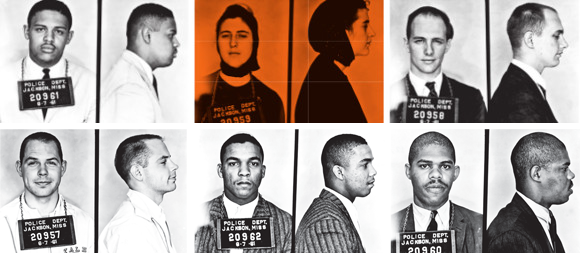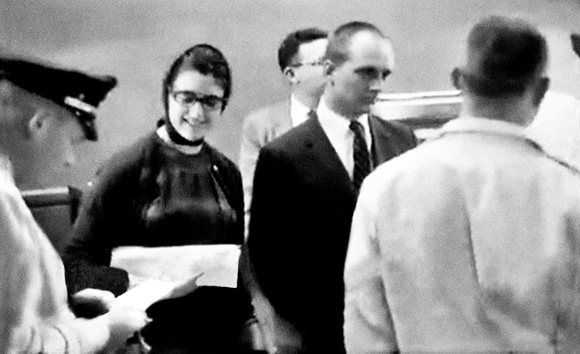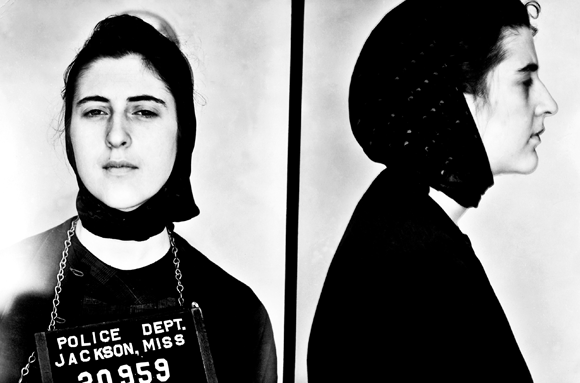
Freedom Rider Diary
A 1961 bus ride to the South ends in a prison cell.
Carol Ruth Silver, AB’60, JD’64
On May 4, 1961, the first group of civil rights activists known as Freedom Riders boarded two buses in Washington, DC. Their destination was New Orleans; their intent was to desegregate bus travel in the South.
The Supreme Court had ruled segregated buses unconstitutional in 1946, and segregated terminals in 1960. But the federal government had done nothing to enforce the ruling.
In Alabama, a Ku Klux Klan mob firebombed one of the buses and tried to trap the Freedom Riders inside to burn to death. The other bus was attacked by a mob armed with baseball bats, pipes, and chains. The riders had to complete their journey by plane.
But the protests did not stop. More than 400 Freedom Riders joined the movement during 1961. Among them was 22-year-old Carol Ruth Silver, AB’60, JD’64. Silver, who went on to a distinguished career in law and politics, was honored with the Alumni Association Public Service Award in 2009.
Excerpted and adapted with permission, including photos, from Freedom Rider Diary: Smuggled Notes from Parchman Prison (University Press of Mississippi, 2014).
New York
Sunday, May 28, 1961
And why not me? I have no excuse for not going—I am not in school, my job is not permanent, financially I can afford to spend two months or so not working. I can even afford a bus ticket to Jackson, Mississippi, since all year I have been planning to take a bus trip this summer.
The idea of my going first occurred to me a couple of nights ago. I think that even then it was already in the form of “why not?”
But it is such a big step.
Next year is my first year of law school. Will something like being sent to jail in Mississippi keep me from taking my bar exam three years hence? Would the University of Chicago refuse me a scholarship or even kick me out of law school if it found out that I had a jail record?
But the students who have already gone on the Freedom Rides have just as much to lose as I do.
My mother gave me a lecture once, in the completely different context of being a Jew, about the necessity of standing up and being counted. There comes a point where it is no longer sufficient to stand up and say “I believe” in such and so; eventually one must prove it by actions. And I guess my time has come.
Monday, May 29, 1961
I tried calling CORE (Congress of Racial Equality) today, but the person I was supposed to talk to was not around. The office there sounded like a madhouse.
About the only thing I accomplished all day was finally to complete and mail off the last of my scholarship applications. Of all the private foundations I have approached, about the only one which looks at all likely is the Educational Foundation for Jewish Girls, so I am really banking on getting something from the University of Chicago itself.

Silver and her fellow Freedom Riders are processed by the Jackson, Mississippi, police after their arrest for breach of the peace.
Tuesday, May 30, 1961
About eight o’clock, after having tried all day to no avail, I finally reached Gordon Carey at the CORE office.
“My name is Carol Ruth Silver . . . What I want to say, I mean . . . I want to be a Freedom Rider!”
“That’s very fine.” (A pause.) “Are you a student?”
“No. I graduated from college at the University of Chicago in June of 1960.”
“How long are you willing to stay in jail?”
“Well . . . how long will I be sentenced to stay in jail for?”
“The original group got a suspended jail sentence and a $200 fine. They are now all in jail serving out the fine at the rate of $3 per day. That means they will be in for 67 days. However, the judge has threatened to increase the sentence if the rides continue. Freedom Riders are being asked by CORE to stay in jail for a minimum of two months.”
For a second I stopped short—I had figured on about thirty days.
“But wait a minute—what if our sentences are longer than that? I’m entering law school this fall, and have to be back in Chicago on the 15th of September.”
“Each person who gets out on bail costs CORE $500, because we have to put up cash bonds. That’s why we want you to stay at least two months. We promise to bail you out after that.”
“That sounds very fair. I can commit myself to two months.”
“Now, here is what you have to do. When you get to Atlanta, call SCLC, the Southern Christian Leadership Conference. They will have been notified that you are coming down and will know when there will be a group leaving for Jackson. Are you going to get to Atlanta by bus?”
“Yes. And I intend to buy a ticket all the way through from here to Mexico City, since I was planning to go there and I might as well continue on to there whenever I get out of jail.”
“That makes you an international passenger.”
“Yes, and someone was telling me that I should have some special rights under the Geneva Convention on International Travel.”
“Well, since Mississippi does not seem to recognize the government of the United States, I doubt that you can do anything about it. It might be interesting to try, though.”
Wednesday, May 31, 1961
I wonder if I can really be nonviolent. My training in the New York subway system has made it almost automatic that if someone shoves me, I shove back. If some young punk came up to me and started beating me over the head, would I really be able to so discipline myself that I could just stand there and take it? The spirit is willing—I sincerely do believe that the nonviolent method is the only way to conduct civil rights protests—but when it comes to overcoming such a basic human trait as self-defense, I can only hope that I will be strong enough.
And if I can be nonviolent, and if we are attacked, what if I should get badly hurt? Blinded perhaps? Even killed? If I should be crippled for life, would it have been worth it?
I wonder what jail will be like. When I talked to Mr. Carey’s secretary, she warned me that we would possibly be put in with real criminals—white, southern criminals. She also said that people are not being allowed to have books in the jail. Can I spend two months cooped up in one small area with nothing to do but contemplate the Ultimate Nature of Being?

Left: Carol Ruth Silver spent 40 days in Mississippi jail cells, including the maximum security unit at the infamous Parchman Prison Farm. Right: A bus brings the Freedom Riders to another Southern town.
Thursday, June 1, 1961
Today I bought my Greyhound bus ticket—Mexico City by way of Atlanta, Georgia; Montgomery, Alabama; and Jackson, Mississippi. The ticket clerk assured me that on my ticket I could stop off for as long as I like (up to a year) at any of the cities on the way.
Even to my closest friends, I did not have the courage to say that I was going to be a Freedom Rider. I said that I would “probably” join a group of Freedom Riders in Atlanta, that I would “probably” be arrested in Jackson, and would “probably” be in jail for about two months. If I chicken out, I will not have quite so much embarrassment explaining my change of plans.
What does one take for a vacation in jail? The only practical thing I could think to pack was some athlete’s foot preventative. I put a thin pad of paper and four cheap ballpoint pens into my bag so that I can write letters.
Friday, June 2, 1961
And I’m off!
I got no feeling of impending adventure as I boarded the Greyhound bus. It was the same kind of bus in which I had traveled thousands of miles before. There are relatively comfortable reclining seats covered in the usual strange kind of woven plastic with silver specks.
People always seem more friendly and open to talk on buses than on trains. Today’s ride to Washington, DC, was with a young man from Virginia, whom I am afraid I antagonized almost as much as he did me. (I had resolved when I first decided to go on this Freedom Ride that Principle of Action Number One was not to get into any arguments with segregationists whom I might meet casually on buses. But I felt that this ride from New York to Washington was still my own territory.)
Traveling South
Sunday, June 4, 1961
To the northerner, to me, the honeysuckle was the first thing apparent in Virginia, an odor amazingly sweet and clear and fresh, and all-pervasive. The second thing I noticed was segregation, equally common and clear.
At Statesville, North Carolina, a little town about an hour outside of Charlotte, I first actually saw “colored” and “white” over the doorways of separate waiting-room entrances. I did not get off the bus but watched the other passengers divide into separate docile streams and pass under the two signs. I wondered how the Negroes on our bus from New York felt at that moment.
Monday, June 5, 1961
Earlier this week, on June 2, 1961, a ten-day restraining order had been issued by the Alabama federal district court (Judge Frank Johnson Jr.) to enjoin CORE and the movement from sending any more organized groups through Alabama.
CORE was therefore bypassing Alabama altogether, and had moved the rendezvous point for Freedom Riders going into Jackson from Montgomery, Alabama, to Nashville, Tennessee. So at 5:45 p.m. I left Atlanta on a train headed northwest, along with two white divinity students from Yale, Ed Kale and John Gager, who were also taking this roundabout route to Jackson, Mississippi.

Tuesday, June 6, 1961, Nashville
Since the Negro students with whom we were to travel were due to arrive about midnight from Richmond, Virginia, we spent the day hanging around the Nashville “office” of the Student Nonviolent Coordinating Committee (SNCC, pronounced “Snick”)—an unfinished house under construction near Fisk University.
All day long students from Fisk kept dropping in. I was immensely impressed by the religious feeling which most of them exhibited and by their complete acceptance of the Gandhian principles of nonviolence. Most of them had been in many civil rights demonstrations. One of them, I think it was William Barbee, related his experiences in Alabama, where he had been beaten badly and then, lying on the ground at the feet of his assailant, held out his hand and said, “Brother, I love you.” It sounded unbelievable, but I am sure it is quite true. During this time, we received a little formal training in the tactics and practice of nonviolence, and lots of informal advice and counseling from the students who had experienced it.
We met the three Negro divinity students, Reggie Green, Raymond Randolph, and Obadiah Simms, all from Virginia Union University Divinity School in Richmond, at the Trailways bus station at 9:30 p.m. We decided that we would all take the bus for Jackson at 1:15 a.m. The hours between their arrival and our departure were spent in the station, getting acquainted, drinking coffee, and talking to Rick Smith, a lone reporter, from United Press International, who turned up.
We left on schedule with a minimum of wisecracks from the driver—and only the UPI reporter to see us off.
The Crime
Wednesday, June 7, 1961
The ride through Tennessee and Mississippi was relatively uneventful. Two police cars fell in behind the bus at the Mississippi border and, sometimes joined by more, followed us all the way to Jackson.
As we drove through the city, all traffic was cleared ahead of our bus by police stationed in the intersections. We six Freedom Riders waited until everyone else got out of the bus before we held hands, said a prayer, then debarked from the air-conditioned bus into the hot, bright sunshine. For a few moments we were alone on the platform with the bus driver unloading luggage—three Negro divinity students from Virginia Union University, two white men of God from Yale, and a nice Jewish girl from New York.
In the shadow of the terminal I could see many uniformed police, a few men with cameras and notebooks, and some bus drivers. We shook hands with each other and moved forward to our destinations—the Negroes to the waiting room marked “white waiting room intrastate passengers” and the whites to the door marked “colored waiting room intrastate passengers.”
As we started walking in, a grinning reporter came up and asked if we were the Freedom Riders and whether our names were correct on his prepared list. “We were told there was a white woman in the group, but that she would probably not go through with it.”
“Well, that certainly did not come from me,” I replied and passed by him into the waiting room designated for Negroes.
Inside, our reception committee consisted of more police, all of them white, all armed, all looking terribly serious. I saw no Negroes or regular passengers in this waiting room. The whole thing, the elaborate preparations, the guns, the deadly serious police, contrasted sharply with the almost holiday-like, victorious mood in which we had been riding on our bus, traveling through the South, based simply on the fact that we had not been met by a mob with clubs, at least not yet.
A police officer stepped forward with great determination. “Move on!” he said. John Gager, our unofficial spokesman, replied, “We just want to get some coffee,” and I at the same time piped up: “I just want to use the restroom, please.”
“Do y’all refuse to move on?”
John: “Yes, sir.”
“Then y’all are under arrest.”
The police too, like the UPI reporter, had merely to verify our names on a typed list. The Negro students, who had obviously been subjected to the same treatment on the “white intrastate” side, joined us in the paddy wagon, and we rode to jail together. Someone said gleefully, “I bet this is the only integrated public transportation in the state of Mississippi.”
At the jail, we gave our names and our personal information, then our pictures were taken, full face and profile, with numbers on little wooden signs hung around our necks. Our fingerprints were made and our possessions and eyeglasses taken away from us.
The whites had been taken first while the Negroes were ordered to “stand back.”
The formalities over, I quickly shook hands with my companions and was conducted to a cell door labeled “adult white females.” Over other doors I could see other labels—“juvenile Negro males,” “adult white males,” and, mysteriously, “other adult males.” The “adult white females” door opened and then closed behind me with a deafening metallic clang.
